Ecommerce Pricing Strategies
Table of Contents
What You’ll Learn
- How to make more profit from your product pages.
- How to think strategically about your pricing to make a higher profit margin.
- How pricing strategy can create motivation, improve decision-making, and improve the emotional appeal.
- How some strategies work better on one age group versus another.
Introduction
As an ecommerce merchant, you can’t take pricing for granted, or discount its impact on sales. Simply offering the lowest price in your category can often lead to poor results or even financial ruin; whereas in many cases, charging more than your competitors, or offering unique pricing strategies, bundles, or payment options can drive substantially more sales and profits.
As with most everything, the best way to determine which strategy will be the most effective one for your business is to run properly conducted A/B split tests to find what works best for you.
Let's take a brief look at the seventeen most effective ecommerce pricing strategies that you should consider when building your webstore. These include:
- Discounting
- Adding bonuses and value
- Showing the savings
- Charm pricing
- Left digit bias
- Exact pricing
- Extreme aversion
- The decoy effect
- Anchoring
- Tripwires
- Bundles
- Context pricing
- "One price" pricing
- Skimming
- Installment pricing
- Breaking it down
- Blue ocean pricing
Discounting
Generally, the more you discount, the less quality, and service you can afford to offer, which diminishes the value of the product even further.
Once you start discounting, people assume the regular price is too high, making it more difficult to justify the original price. Not to mention that once you start discounting, so too does your competition, creating a race to the bottom where everyone's margins suffer and few survive.
Discounting also reduces your profit margin and your ability to fund research and development and aggressive marketing.
The Zappos growth strategy (and grow they did) was not to offer discounts, but to offer better service, free shipping both ways, a one-year return policy, nicer support people, and a larger selection of sizes in the newest styles.
Adding Bonuses and Value
Avoid the incipient urge to discount creating constant sale events and promotions. This is lazy marketing; it’s easy to drop your price in order to generate some quick sales, but adding more value, and maintaining—or even increasing—your price is often the path to better margins and sales.
Rather than discounting, add more value with bonus items and a stated price (which establishes the value) for each bonus item. For example, you can put a price on each of the products and services that you currently offer along with the product (in essence, for free), thereby creating a much higher overall perceived value.

Show the Savings

This presentation is better than saying "Save 12%."
Why say "Save $60" rather than "Save 12%"?
Because 60 is a larger number than 12, it registers as a much greater value in the shopper's mind. And a percent off does not establish the real dollar value of the customer's savings as quickly and straightforwardly as simply stating that value.
Remember:
- Don’t make people do the math.
- Don’t make people think.
Charm Pricing
Charm pricing ends with a .99 rather than a round number: $6.99 versus $6.00 or $7.00. When you add the .99 to the $6, you make an extra 99 cents, yet most people lock onto the first digit, seeing the price ($6.99) as $6 rather than $7.
When you use $6.99 rather than $7.00, the perceived price is one dollar less ($6 vs. $7), because people have a left digit bias, where they focus on the 6, not the full 6.99.
Left Digit Bias
The digit furthest to the left is more influential and remembered than any other digit in a price.

You can test not using a dollar sign so that the price is represented as a number rather than money. You can also make the charm digits smaller than the left digit, which reduces their mental impact.
Exact Pricing
Exact pricing (a.k.a. sharp price) means exactly what it sounds like listing the exact price rather than rounding to a whole number (or even using charm pricing): $4.93 versus $5.00. Exact pricing typically works best in discount environments, or where people expect savings down to the penny. For example, Walmart uses exact pricing when they end in ".48" or ".67."
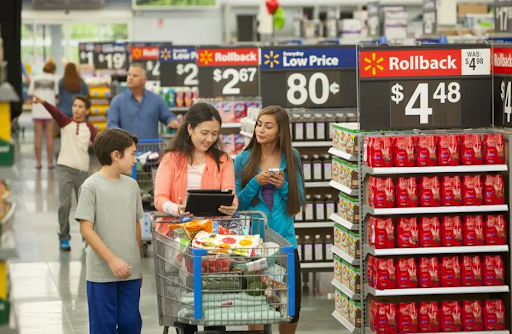
Extreme Aversion
People generally avoid the cheapest and the most expensive options, as they don’t want to look like either a cheapskate or an extravagant spender. They also tend to believe that the best value is in the middle.
This strategy typically works best on utilitarian products and with older adults.
Look at these examples of pricing for automobiles, and what you will see is that these models were strategically created and priced to provide three price and feature options:
- S $27,999
- SE $31,999
- SEL $34,999
It’s the SE model in the middle that will sell more than either of the extremes.
- S $27,999
- SE $31,999
- SEL $34,999
There are also times when a fourth option is added to the list. In this scenario, when a super-premium model is added at the top end, the SEL will sell more. Manufacturers and service providers will often introduce a super-premium offering for the primary purpose of driving more sales to the premium option:
- S $27,999
- SE $31,999
- SEL $34,999
- SEL Touring $44,999
For the small percentage of people who choose the super-premium offer, the manufacturer has the maximum profit margins built in.
In addition to generating higher margins and driving more premium model sales with a super-premium offer, the company also creates a “halo effect” for the brand by showing that they are capable of producing really awesome, envy-evoking, aspirational products.
For example, the Corvette sells very few units, but the awe-inspiring technology, styling, performance, and price cast a positive halo over the entire Chevrolet brand.
The Decoy Effect
The decoy effect happens when you show an option that causes the buyer to compare multiple products and prices and be driven to the one target item that you really want to sell at volume.
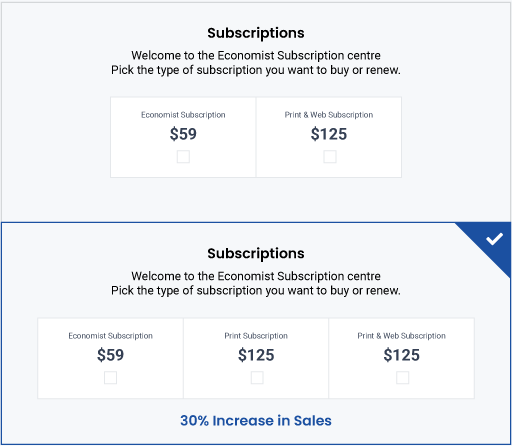
The decoy is purposefully designed to be a lesser overall value, with the same or higher price, but with fewer features or benefits. In this way, you are highlighting the choice you want the buyer to make by showing that one to be a great value in contrast to the decoy.
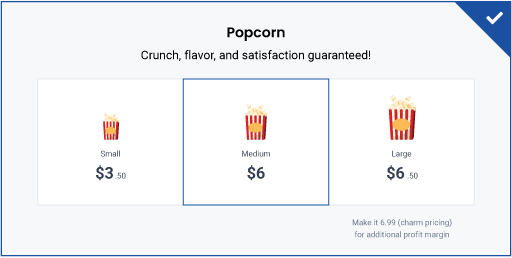
The decoy strategy works best with younger adults.
Anchoring
Studies have shown that the first fact, example, price, or number presented is what people typically remember. This is the one that people use as a comparison, reference, and anchor point for all succeeding prices.
An interesting example of this is how exotic and ultra-luxury cars are often sold at plane and yacht shows, not car shows. Here's the trick: the cars are shown after the more expensive products are displayed. So when you see a $7 million dollar yacht, and then you see a Rolls Royce that costs $500,000, the normally expensive car looks very affordable in comparison.
The other psychological effect that’s taking place here is the principle of “context.” When the car is shown alongside a super expensive luxury item, the car is associated with elitism and ultra extravagance, which is exactly what the yacht buyer wants to convey as their persona.
Anchoring is also why, in most situations, a freemium offer is not always the way to go. Research shows that only 1% to 10% of people upgrade from a freemium because they are often anchored to and fixated on "free." Personally, I am stuck on the free Pandora music option, because after enjoying it for free, I can’t justify paying anything for it.
Unless you have the cash reserves to build and support a freemium product, along with a solid upsell strategy that makes the freemium too painful to use and the upsell too good to refuse, freemium is often a path to insolvency.
So be aware that if you anchor your product to a low price at first, you need to work extra hard to build value and justify a higher price, which usually does not happen.
Or, you can anchor your product to a high price, follow up with a lower price, and create the impression of an excellent bargain.
Steve Jobs and Apple were very skilled at the arts of persuasion and price anchoring during product launches, making product launches a unique strength of Jobs. In fact, many books have been written about his legendary product launches, presentations, speaking skills, and of course, his mega-creative, intuitive business and product insights.
When Apple launched the iPad, Jobs stood next to the price of $999 showing on a large screen while he was presenting the features, specs, and attributes of the exciting new product. He never explicitly said the price would be $999 or even referenced the price, but it was implied, creating a mental anchor point.
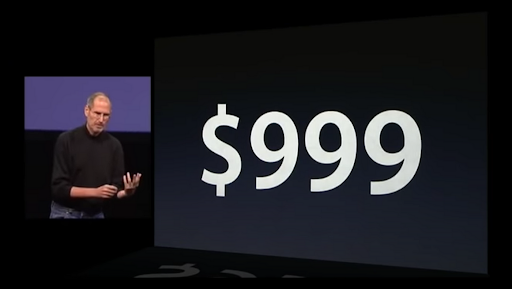
Eventually, after building the story and immense value behind the product (and more than justifying the perceived $999 price), Jobs unveiled the actual prices, sending the audience into "oohs," "ahhs," cheering, and clapping. Jobs was a master at storytelling, presenting, conveying passion and excitement, and building value.
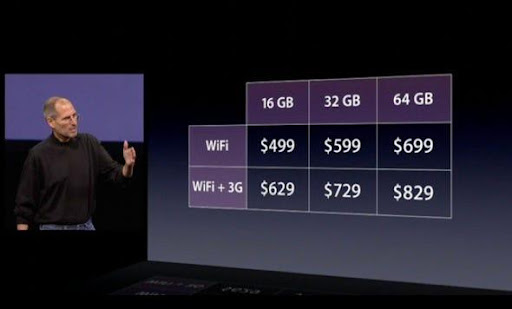
Here's yet another example. In these A/B split tests, which pricing presentation do you think generated more sales?
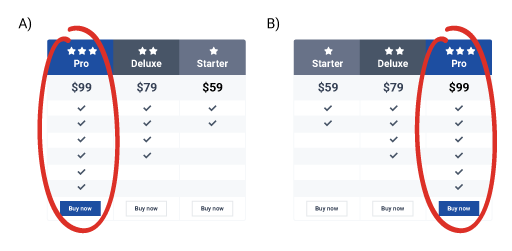
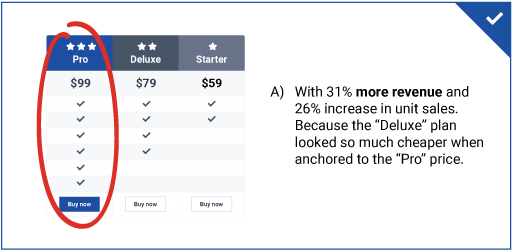
Or take the following example.
This software company established an anchor price of $99, followed by the target product at $49. They also offered a free 30-day trial; a 60-second sign-up; and the ability to upgrade, downgrade, or cancel at any time. Finally, they showed social proof by stating that the $49 per month offering was the “Most Popular Plan.”
These are known as risk mitigation or “reversibility” strategies, which instill confidence, and allow the user to try out the product risk-free, thereby removing the immense friction of uncertainty that holds people back from buying.
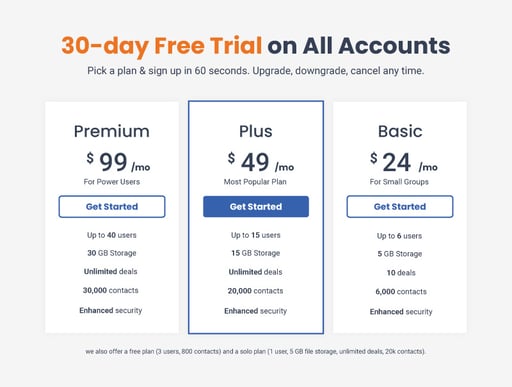
Tripwires
Tripwire marketing is a powerful conversion strategy that convinces consumers from your target market to buy something small from you rather than buying nothing at all. This could be a sample, a starter pack, or one product from a bundle.
With tripwire marketing, the intention is to establish the massive value of your core product and then offer the purchase of a low-cost alternative that you are selling at a fraction of the price of the entire bundle or primary product.
For example, if you are selling a comprehensive, twelve-part course for $997, you can offer a single introductory course for $47 just to get the buyer started.
This super low-priced alternative is irresistible compared to the full program price, and accomplishes several objectives:
- It creates a sale and generates revenue.
- It increases your overall conversion rate.
- It solidifies the foundation of credibility and value you established to make this initial sale. Since some buyers are either too cheap or are uncertain about taking the full plunge and want to wade in slowly, the tripwire "gets them in the water."
- It gets people to open their wallets—which is the hardest part—and once they have purchased from you, momentum is on your side and it becomes easier for them to spend more with the next purchase.
- It is like a free trial or a freemium, but better, because spending money means they have "skin in the game," so they will value their purchase more than they would a free option, which makes them more likely to use it, see the benefit, and come back for more.
- It creates a bit of reciprocity. If you give them an incredible value for a very low cost, they may feel compelled to reciprocate the favor and buy the main offering.
- It creates a lead for upselling: an actual paying customer, who is now 16x more likely to buy again (and spend more the next time).
Some marketers promote the tripwire as an irresistible lead magnet, and others use it as a last-ditch offer (exit pop on a website, for example) if the shopper doesn’t buy the primary product. Test both to see how tripwires work best for your products and target market.
What's more, with appropriate tweaks, the tripwire can be implemented throughout your funnel:
- Top-of-funnel: Use SEO and content marketing to drive traffic to your landing page, then offer an insane value for an irresistibly low price with a tripwire offer. This strategy is a great way to drive your conversion rates, generate leads, and build your drip campaigns.
- Mid-funnel: Create an email drip campaign that promotes your tripwire offer to send to an email list made up of those who converted on your free lead magnet. This keeps those customers engaged with your brand.
- Retention or cart abandonment: Bring customers back with an irresistible offer on something of immense value, then drop them into a drip campaign that promotes your premium offer.
A tripwire is also a great way to introduce a new product. Rather than just offering the whole product, offer a tripwire version, then use a drip campaign to get the customer to buy the larger item.
PRO TIP: Create a tripwire from your most popular product, because this is where you will generate the most traffic, conversions, and upsell opportunities.
Bundles
When you bundle products into a single price, it makes decision-making easier and provides a higher perceived value overall. It also makes dissecting the actual price of each individual item difficult to nearly impossible—especially if the bundle includes something unique to you.
You have probably noticed that a decade or so ago, the automotive industry stopped offering cars with multiple options, where you could individually select features such as leather seats, a moonroof, a premium sound system, or a higher-performance engine. These days, the desired options are sold as part of a package, or trim level. This simplifies decision-making for the consumer, makes manufacturing and inventory control easier for the manufacturer, and provides a higher margin for the dealer.
Context Pricing
It’s the context, the proximity, and the relationships between things that establish the relativity of everything.
In the world of retail branding, the context is critical to establishing value and price. This includes the retail location, the retail environment, packaging, lighting, displays, service levels, and so on. These elements are what create the brand expectations, positioning, and the brand experience.
Think of how your expectations, satisfaction, and experiences change between the county fair and a Disney theme park, or the Ritz-Carlton and Motel 6. Completely different context, and expectations in terms of cost and experiences.
It's the context that establishes the perceived value, expectations, and—in truth—the level of joy or satisfaction the consumer experiences and remembers about the brand.
A great deal of psychology and attention to detail goes into creating a memorable and powerful brand.
This psychology applies to your website as well. Things like the design, copy, images, fonts, colors, use of negative space, number of columns, and the overall UX of a website all provide context for pricing. You simply can't justify a premium price on a low-end-looking website.
Price, therefore, is relative to the brand experience, or context, in which it is presented.
For example, $6 for a 12-ounce cup of coffee at Starbucks in a Las Vegas resort may seem reasonable given the context of the retail environment, but $2 for the same 16-ounce cup at McDonald’s would seem high.
Or how about $9 for a dinner salad at a fancy restaurant versus $3 at a diner for essentially the same salad?
In a classic example of how price is directly affected by context, Payless ShoeSource was able to prove that they could actually sell shoes at a much higher price and margin when they created a fake luxury brand—Palessi—which was actually filled with Payless shoes.
As part of a viral advertising campaign designed to shift consumers' perceptions of the brand, Payless built a temporary store in a luxury shopping area in Santa Monica, California, and filled it with fashionistas. Once the "Palessi" label was added, they were able to prank VIP shoppers into paying markups of up to 1,800 percent for the same shoes sold at their bargain locations.
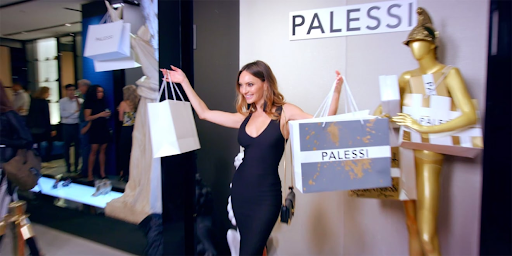
Context pricing is like branding: you need to match the brand image and visual branding with the product and the target audience to fit the right price category.
"One Price" Pricing
In general, people prefer a flat monthly flat that is predictable and easy to plan and budget for, rather than paying for individual transactions and having variable costs.
This is because each transaction impacts the budget, and requires a decision and payment, all of which are pain points. Every time someone has to make a payment, they are reminded of the cost, which causes them to analyze the value of the product or service as well as the effort required to make the payments.
In the modern era, people are inundated with hundreds of decisions, both large and small, every day. This leads to decision fatigue, wherein people get exhausted and overwhelmed by even small, inconsequential decisions.
Because of this, people are attracted to situations where they do not have to put forth very much thought or effort in order to move forward.
Not long ago, my wife and I visited a resort where they did not accept cash, nor did they have dollar signs on anything. They even encouraged you to charge everything to your room to receive extra travel points.
The point of these subtle strategies was to separate the guests as much as possible from the pain of realizing that they were actually spending money—let alone just how much they were spending. By charging everything to the room, and not having a dollar sign on anything, just a number, you had fewer reminders of the real cost—which reduced anxiety and increased spending.
So look for ways to offer a single price strategy where possible:
- All-inclusive
- Resorts
- Cruises
- Buffets
- Cable and Wi-Fi
- Cell carriers
- Flat rate pricing
- Fixed prices
Skimming
When introducing a brand new or unique product, start high and “skim” the market of early adopters to maximize your profits. Later, as the competition heats up (or the newness and novelty wears off), you can lower the price to get market share.
Later still, as the market becomes more saturated and competitive, you can offer even lower-priced options with fewer features, smaller sizes, lower quality, or less service and support.
Installment Pricing
“Enjoy today … pay later with instant financing or credit card.” This is a common strategy that has been around a long time, yet still works.
If you want to offer installment pricing, make sure that you have made it perfectly clear to customers that payment and financing options are available.
Breaking It Down
Another way to reduce the perceived pain of the price is to break down the cost into smaller increments, also known as “breaking it down to the ridiculous”:
“Only 19.99 per month”
On the other hand, there are some who feel this strategy has its own negatives, such as:
- It takes the focus away from the product—and the buyer’s desire for that product— and focuses attention squarely on the cost.
- What if the buyer doesn’t agree with you about the value? What if they think the daily price is a lot of money? This could cause friction.
- It could make your buyer distrust or dislike you.
Blue Ocean Pricing
When they zig, you zag.
In order to offer a sustainable discount strategy for example, you will need to eliminate features and services of little benefit to the customer, especially those things that have a high operational cost, and then double down on features and services that people really value, and which allow you to differentiate.
By eliminating meals, premium airports and gates, class-based seating, VIP lounges, and seat reservations, Southwest Airlines was able to offer lower fares, free bags, and no-fee ticket changes.
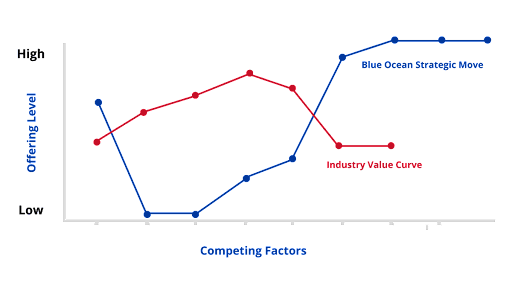
Summary
This article discusses various pricing strategies for ecommerce businesses to increase profits. It emphasizes the importance of strategic pricing rather than simply offering the lowest price.
Discounting can diminish the product's perceived value and reduce profit margins. Instead, adding value through bonuses and showcasing savings can be more effective.
The article also explores the use of charm pricing, left digit bias, exact pricing, extreme aversion, decoy effect, anchoring, tripwire marketing, bundling, and the influence of context on pricing.
Additionally, it shows how strategies like "one price," skimming, installments, breaking down costs, and blue ocean pricing can attract customers and increase sales.
Finding the best pricing strategy for your ecommerce business is a matter of evaluating your sales and growth goals, the pricing of your competition, the behaviors and budgets of your target market, your marketing budget, and your brand strategy.
The pricing strategy that works best for you will ultimately depend on a mix of those factors based on which are most important to you. You may also need to do some testing to see what approach creates the most excitement and engagement for your audience.
Further Reading
Is Your Website Costing You Money?
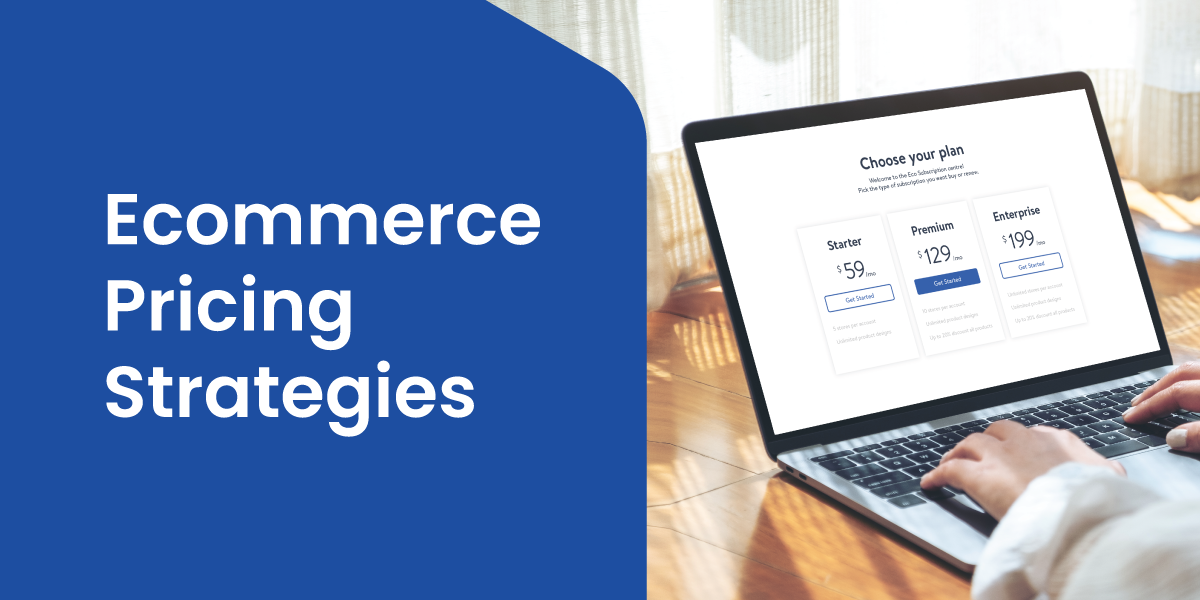
 Drive More Visibility, Traffic, and Sales
Drive More Visibility, Traffic, and Sales
